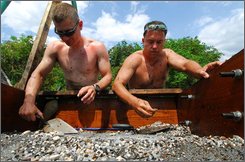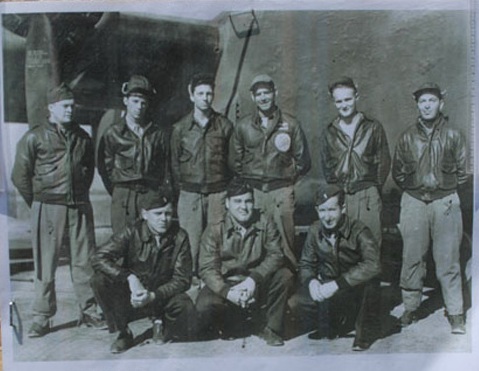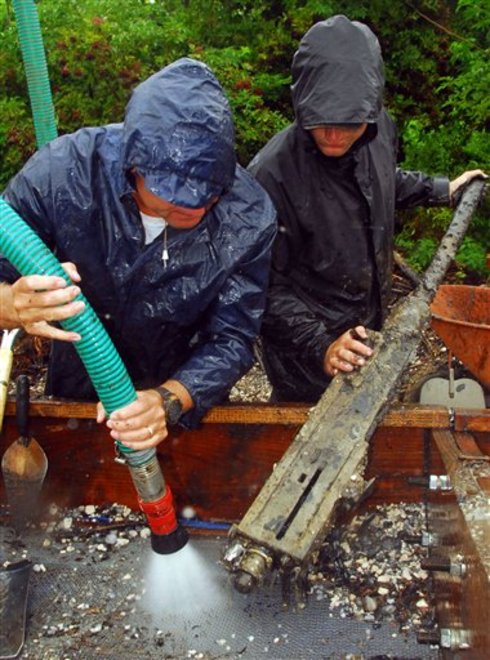Martin F. Troy
- Staff Sergeant, U.S. Army Air Forces
- Service # 31313507
- 760th Bomber Squadron, 460th Bomber Group, Heavy
- Entered the Service from: Connecticut
- Died: 30-Jun-44
- Missing in Action or Buried at Sea
- Tablets of the Missing at Florence American Cemetery
- Florence, Italy
- Awards: Air Medal with 2 Oak Leaf Clusters, Purple Heart
10 August 2007:
BUDAPEST, Hungary — The remains of a U.S. airman whose plane was shot down over Hungary in World War II have been recovered from wreckage left unexcavated in a rural area for 63 years, American and Hungarian officials said Friday.
The remains of Staff Sergeant Martin F. Troy were found among the wreck of a B-24H “Liberator” bomber in the village of Nemesvita, about 110 miles southwest of the capital Budapest. They will be returned to the United States, officials said.

on Friday Aug. 10, 2007, shows Sergeant Andrew Whicker, left and Sergeant Graham Hilson, right, searching for
the remains of a U.S. airman shot down over Hungary during World War II. The remains of Staff Sergeant
Martin F. Troy were found among the wreck of a B-24H “Liberator” bomber in the village of Nemesvita,
about 180 kilometers (110 miles) southwest of Budapest, the capital. Troy was the tail gunner on the bomber
nicknamed “Miss Fortune,” which was returning from a mission in Germany to its base in Italy.
Troy’s aircraft flew into bad weather and was shot down by German Messerschmitt 110s over western Hungary on June 30, 1944.
(Joint POW/MIA Accounting Command of the U.S. Military Forces, Sergeant Michael Johnson)
The location of the wreckage has been well known since the time of the crash — seven of the bomber’s 10-man crew bailed out and the survivors gave an account about where it went down. They said Troy had likely died. But no one has gone back to thoroughly search the site since.
Troy, a native of Norwalk, Connecticut, was the only member of the bomber’s crew who had yet to be fully accounted for. Though the identity of the remains must be confirmed by DNA testing, officials said there was virtually not doubt they belonged to Troy.
“After 63 years of being listed as ‘killed in action, body not recovered,’ this airman’s family can finally experience closure,” U.S. Ambassador to Hungary April H. Foley said at a ceremony to officially hand over the remains to the U.S.
The recovery was carried out by the U.S. military’s Hawaii-based Joint POW/MIA Accounting Command, or JPAC, which identifies and recovers American soldiers killed in conflicts around the world.
Tens of thousands of people from some two dozen countries were known to have been killed during the war in Hungary, which was invaded by Nazi Germany in 1944. The country was then under communist rule until 1989 and would not have allowed an American military team in to search the crash site.
The wreckage was deemed “unrecoverable” in 1945 by the American Graves Registration Unit, because of its location. The bomber crashed into marshy land, creating a crater some six yards wide by 18 yards long which was covered by 2-3 feet of water.
“The site of the crash had been heavily salvaged over the years … probably during the war,” said anthropologist Bradley Sturm, the only civilian on the JPAC team. “Given the fact that there were tons of metal in that aircraft, there was hardly anything left.”
He said Troy’s bones were scattered around the crater caused by the crash, a few miles from Lake Balaton on privately owned land.
JPAC began making efforts to recover Troy’s remains two years ago “because of congressional interest,” said Marine Captain George Murphy, the military leader of the JPAC team. One of the surviving crew members and other veterans lobbied for the JPAC mission. The original survivors from Troy’s crew are all dead now, Sturm said.
Murphy said JPAC’s limited resources also held up the search for Troy’s remains. The group has only five teams to search for about 80,000 Americans still missing from World War II.
Sturm said the excavation of the wreck took 30 days and an engine and three propeller blades were among items recovered from the bomber.
“There is a good chance that Troy died before the plane hit the ground,” Sturm said. “There was a big fire involving a leakage in the oxygen system and another crew member was badly burned trying to get to him.”
Troy was the tail gunner on the bomber nicknamed “Miss Fortune,” which was returning from a mission in Germany to its base in Italy. His aircraft and three others flew into bad weather and were shot down by German gunners over western Hungary on June 30, 1944.
JPAC will attempt to return Troy’s remains to his family if it can be found. He could be buried at Arlington National Cemetery, outside Washington, D.C.
Lieutenant General Jozsef Hollo, director of Hungary’s Military History Museum, said there was information about another 30 American soldiers killed in Hungary during World War II whose remains had yet to be recovered.
Family of missing airman hoping for closure
Wednesday August 15, 2007
NORWALK, Connecticut — Family members of a missing World War II airman say decades of questions may have been answered with the recent discovery of human remains where his bomber was shot down over Hungary.
Staff Sergeant Martin Troy was among 10 crew members on a B-24H Liberator bomber shot down by German forces on June 20, 1944. The 32-year-old airman was the tail gunner, and was the only crew member who had yet to be accounted for.
American and Hungarian officials announced August 10 that remains believed to be Troy’s had been recovered and would be repatriated. The U.S. Department of Defense is performing further tests to confirm his identity, which could take another two months.
Barbara Mosley, Troy’s niece, will accept the remains along with two cousins, Benjamin Sugden and Thomas Bers.
Mosley said she learned of the discovery while reading the newspaper near her home in South Pasadena, Florida.
“I turned snow white. I could not believe what I was reading — it was a shock,” Mosley said. “After 63 years, it’s very weird. Now, we’re trying to decide what to do. There’s not many of us left.”
Troy had four siblings and was married at the time of his disappearance. His widow, Grace, remarried twice and died in 1964.
Troy’s aircraft and three others flew into bad weather and were shot down by German Messerschmitt 110s.

The recovery project was carried out by a seven-member team from the U.S. military’s Hawaii-based Joint POW/MIA Accounting Command, or JPAC, which identifies and recovers American soldiers killed in conflicts around the world.
“The site of the crash had been heavily salvaged over the years … probably during the war,” said anthropologist Bradley Sturm, the only civilian on the JPAC team. “Given the fact that there were tons of metal in that aircraft, there was hardly anything left.”
An engine and three propeller blades were among the items recovered from the bomber, which had crashed into a soggy area a few miles from Lake Balaton.
Sturm said the excavation of the wreck took 30 days, adding that the rest of the members of Troy’s crew, who survived the mishap, had since died.
“There is a good chance that Troy died before the plane hit the ground,” Sturm said. “There was a big fire involving a leakage in the oxygen system and another crew member was badly burned trying to get to him.”
The three cousins have not yet decided whether Troy will be buried in St. Mary’s Cemetery in Norwalk with his widow or at Arlington National Cemetery outside of Washington, D.C.
For now, family members say they are relieved to end a mystery that has lingered for most of their lives.
“I’m just very happy,” Sugden said. “I’m just happy to have some closure.”
U.S. Department of Defense
Office of the Assistant Secretary of Defense (Public Affairs)
3 November 2008
Airman Missing In Action From WW ll is Identified
The Department of Defense POW/Missing Personnel Office (DPMO) announced today that the remains of a U.S. serviceman, missing in action from World War II, have been identified and will be returned to his family for burial with full military honors.
He is Staff Sergeant Martin F. Troy, U.S. Army Air Forces, of Norwalk, Connecticut. He will be buried on November 20, 2008, in Arlington National Cemetery near Washington, D.C.
Representatives from the Army’s Mortuary Office met with Troy’s next-of-kin to explain the recovery and identification process and to coordinate interment with military honors on behalf of the Secretary of the Army.
On June 30, 1944, Troy was on a B-24H Liberator participating in a mission to bomb an oil refinery in Blechammer, Germany. The plane was shot down by German aircraft and crashed into a swampy area near Nemesvita, Hungary beside Lake Balaton. Seven of the crewmembers parachuted to safety where they were captured by enemy forces and subsequently released. Three crewmen died in the crash and the remains for two of them were eventually recovered and identified. Troy’s remains were not recovered.
In 1999 and 2003, Hungarian citizens turned over to U.S. officials human remains supposedly recovered from Troy’s crash site. In 2003 and 2005, Joint POW/MIA Accounting Command (JPAC) teams surveyed the site.
In 2007, another JPAC team excavated the site and recovered human remains and non-biological evidence.
Among other forensic identification tools and circumstantial evidence, scientists from JPAC and the Armed Forces DNA Identification Laboratory also used mitochondrial DNA in the identification of Troy’s remains.
Funeral of war hero, lost decades ago, reunites a family
By Allison Lowe
Courtesy of The Hearst Newspapers
21 November 2008
WASHINGTON – Sixty-four years after his plane was shot down over Hungary, Staff Sergeant Martin Troy was buried Thursday with full military honors at Arlington National Cemetery, a rite that brought together out-of-touch family members united by a common link: They remembered the tall, handsome airman who left Norwalk to fight in World War II. Troy’s sole remaining sibling, 90-year-old Julia Carvutto of Wilton – the youngest of the seven children in the Troy family – was presented with the flag commemorating her brother’s military service.
“It’s finally here,” Carvutto said, referring to the long-awaited funeral. “It’s something I’ll never forget.”
Troy’s B-24 bomber was shot down by German Messerschmitt fighters June 30, 1944, over a swampy area in Hungary while on a bombing mission headed for Germany from an airbase in Italy. Troy was the tail gunner in the bomber, named “Miss Fortune” by its crew.
The crash site was identified long ago, but his remains were not discovered until bones were uncovered in Nemesvita, Hungary, in July 2007. DNA samples provided by Carvutto and her son, William Wilcox, confirmed the remains were Troy’s.
As they came together under gray skies for the church service and burial of the airman who was 32 years old when he died, many of Troy’s relatives expressed relief to see him finally laid to rest.
“It’s just exciting to me that he’s finally coming home,” said Troy’s niece, Carol Malley.
A church service at the small, brick Old Post Chapel in Fort Myer, Virginia, adjacent to the cemetery, was attended by about 30 family members, friends and military officers. The service, which included recitation of the Lord’s Prayer and communion, focused on the complex emotions of gratitude and grief that surrounded Troy’s unique return. It ended with the singing of “America the Beautiful.”
The attendees then piled into cars for a funeral procession to bring his casket to its resting place in the southwest corner of the cemetery, where his grave will lie in a row marked by the cemetery’s signature white gravestones.
Members of the group sat in two rows of green chairs along one side of the grave for a brief ceremony, which included a 21-gun salute and the playing of taps.
Representative Chris Shays, R-Conn., and Jim Himes, who will take Shays’ seat when Congress convenes in January, attended.
Shays, who has gone to several military funerals, said the service was special.
Though military funerals are meant to honor the fallen soldiers, Shays said, they are also a token to the family left behind.
“It’s touching,” he said. “It’s amazing, really.”
Carvutto said she decided to have her brother’s remains laid to rest in Arlington National Cemetery, with military honors, because her brother deserved that kind of burial.
“It was like what you see on TV,” said Troy’s nephew, Benjamin Sugden of Stratford. “It was an honor to be here.”
Family members shared memories of family dinners at the home of Troy’s parents, John and Myra Troy, on Harbor Din Norwalk. Troy and his wife, Grace, who died in 1964, lived next door.
Malley, who now lives in Mansfield, Texas, recalled Troy as the “mild-mannered and sweet” uncle who used to accompany her on walks around the neighborhood when her parents wanted a respite from their then-5-year-old daughter.
Sugden remembered admiring his uncle’s bomber jacket as a young child.
Carvutto, six years Troy’s junior, says she vividly remembers standing outside as two soldiers approached the door to her brother’s home to bring the sad news that her brother’s plane had been shot down.
“In my mind, I knew right away,” she said.
Troy’s remains were submerged underwater in a nine-foot deep crater created by the explosion when his plane crashed.
Troy’s remains were initially termed unrecoverable by the military’s Joint Prisoners of War, Missing in Action Accounting Command, according to Joseph Jerome “Jerry” Conlon, 83, of Roaring Spring, Pa., a fellow airman.
In 1957, John Lenburg, another airman, began contacting congressmen and the Pentagon to urge them to find Troy’s remains. Lenburg was joined in his efforts by another flier, Mike Brown, and, after both men died, Conlon took up the effort and “pestered the hell” out of the U.S. military to find Troy’s remains.
Conlon made three trips to Hungary to push the effort.
In July 2007, Conlon was there when bones were uncovered at the crash site.
Conlon, who recounted the efforts to retrieve Troy’s remains in remarks at Thursday’s church service, said he was “happy in a muted sort of way” to see the ceremony come to fruition. Conlon said he never knew Troy well but “knew him to talk to.”
“There were a lot of people involved in this,” Conlon said, pointing to his contacts at JPAC and a Hungarian citizen, Nandor Mohos, who helped locate Troy’s remains.
Troy’s parting gift to the family may have been the family reunion occasioned by the funeral service, bringing together different sides of the family, whoÊ-Êthough most still reside in Connecticut – had long since lost touch with each other.
Malley said she hopes to bring the family together for a full reunion next summer.
“Even in death, he brought people together,” said Janice said Janice Wilcox, Carvutto’s daughter-in-law. “That’s the gift of this.”
“God works in strange ways,” Carvutto said.
Michael Robert Patterson was born in Arlington and is the son of a former officer of the US Army. So it was no wonder that sooner or later his interests drew him to American history and especially to American military history. Many of his articles can be found on renowned portals like the New York Times, Washingtonpost or Wikipedia.
Reviewed by: Michael Howard

